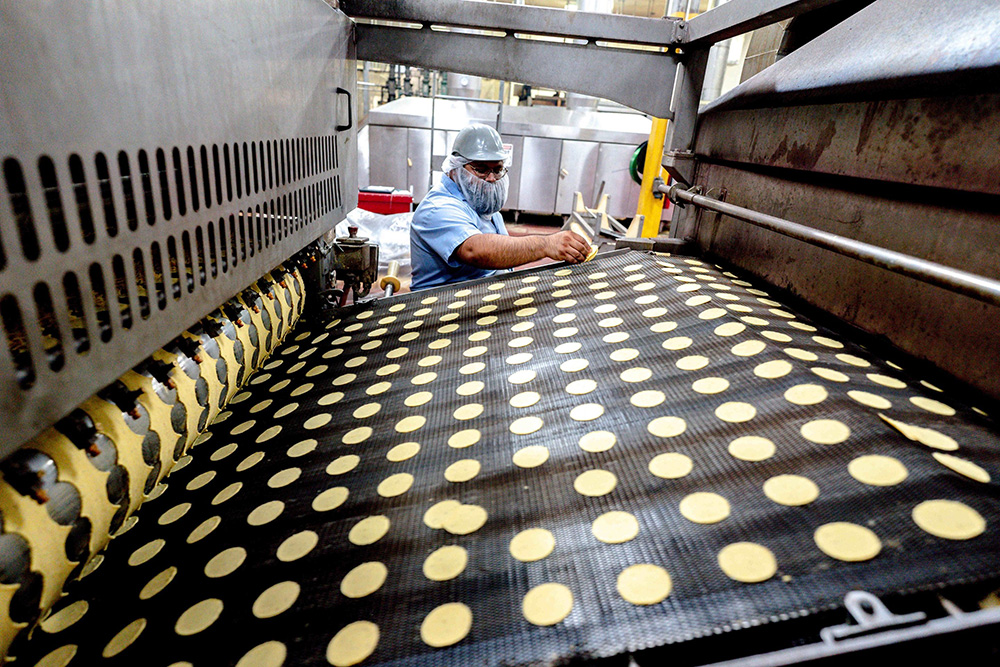美国批发通胀刚刚创下2.5年来的最大单月跌幅

在持续数月的顽固通胀打击了投资者和消费者的情绪之后,美国政府数据显示,物价可能终于开始企稳。今年10月的批发价格大幅下跌,创下自2020年4月新冠疫情爆发以来的最大单月跌幅(新冠疫情造成强制性旅行限制和企业关闭)。
华尔街很快就为这一消息欢呼雀跃,许多人认为这是美联储(Federal Reserve)长达20个月的加息行动正在缓慢遏制通胀的又一个迹象。“我们今天迎来了更多的金发女孩。”TradeStation的全球市场策略主管大卫·拉塞尔在谈到这些数据时说。(“金发女孩经济”指增长进入佳境而通胀威胁尚未来临的经济状况——译注)
美国劳工统计局(Bureau of Labor Statistics)于11月15日公布的数据显示,衡量企业批发价格的工业生产者出厂价格指数(PPI)在10月下降了0.5%。这远低于华尔街对该指数上升0.1%的一致预期,也远低于9月0.4%的涨幅。
10月批发价格的下降也使工业生产者出厂价格指数同比通胀率降至1.3%,而去年同期为8.2%。剔除波动较大的食品和能源价格的核心工业生产者出厂价格指数通胀率上月也保持不变,而市场一致预期为上升0.3%。
AXS Investments的首席执行官格雷格·巴苏克表示:“10月工业生产者出厂价格指数数据低于预期,整体和核心通胀均显示出华尔街、典型的美国中产阶级,尤其是美联储强烈期望的下降趋势。”
批发价格变化预示着消费价格变化
批发价格通胀率的下降对消费者来说是一个好消息,这是因为当企业面临成本上升时,消费者往往首当其冲。正如里士满联邦储备银行(Richmond Federal Reserve)在2022年的一篇文章中所解释的那样,从长期来看,消费者价格通胀和批发价格通胀“同时发生变化”。
在最新的工业生产者出厂价格指数数据发布之前,11月14日公布的消费者价格指数(CPI)通胀报告也低于预期,导致股市大涨。巴苏克称,这两份通胀报告应该能够让美联储官员在2024年降息,为所谓的软着陆(即在不引发经济衰退的情况下实现通胀消退)铺平道路。
经过多年的经济衰退预测,TradeStation的拉塞尔也认为,最糟糕的情况现在已经过去了。他指出,通胀正在消退,与此同时,零售销售额也超出了华尔街的预期,10月仅下降0.1%,而预期为0.3%。华尔街的许多人都认为,这进一步证明美联储实现了经济温和降温(一直以来希望实现)。
重要的是,价格方面的降温并没有给其他经济部门带来降温。衡量纽约州制造业活动的帝国制造业调查指数(Empire State Manufacturing Survey)在10月攀升了14个点。该指数被视为美国整体制造业健康状况的风向标。这可能是一个迹象,表明尽管经济衰退的预测一直存在,但许多经济部门仍然在继续通过加息而获得增长动力。“软着陆正在成形。”拉塞尔说。
“股市唯一合乎逻辑的走向是走高”
对投资者而言,工业生产者出厂价格指数报告是一个好消息。11月14日,由于消费者价格指数数据降温,标准普尔500指数(S&P 500)飙升近2%。11月15日,标准普尔500指数继续上涨,截至午盘上涨0.31%。独立顾问联盟(Independent Advisor Alliance)的首席投资官克里斯·扎卡雷利表示:“目前,通胀正在回落,经济继续保持强劲增长,因此股市唯一合乎逻辑的走向是走高。”
扎卡雷利警告道,高利率、消费者储蓄减少以及信用卡余额上升都表明经济依旧面临衰退的前景。他说:“如果认为可以永远避免经济衰退,那就太天真了。”
然而,这位华尔街资深人士认为,今年投资者的情绪已经变得如此消极,即便是“不那么令人担忧的数据”,比如最新的通胀报告,最终也可能引发股市大幅上涨——“在年底前一路走高”。
AXS Investments的巴苏克对此表示赞同。他说:“最新的通胀报告为那些对2023年剩余时间的利率不确定性心存疑虑的投资者提前送上了一份节日礼物。”他认为,2024年“市场增长前景强劲”。(财富中文网)
译者:中慧言-王芳
在持续数月的顽固通胀打击了投资者和消费者的情绪之后,美国政府数据显示,物价可能终于开始企稳。今年10月的批发价格大幅下跌,创下自2020年4月新冠疫情爆发以来的最大单月跌幅(新冠疫情造成强制性旅行限制和企业关闭)。
华尔街很快就为这一消息欢呼雀跃,许多人认为这是美联储(Federal Reserve)长达20个月的加息行动正在缓慢遏制通胀的又一个迹象。“我们今天迎来了更多的金发女孩。”TradeStation的全球市场策略主管大卫·拉塞尔在谈到这些数据时说。(“金发女孩经济”指增长进入佳境而通胀威胁尚未来临的经济状况——译注)
美国劳工统计局(Bureau of Labor Statistics)于11月15日公布的数据显示,衡量企业批发价格的工业生产者出厂价格指数(PPI)在10月下降了0.5%。这远低于华尔街对该指数上升0.1%的一致预期,也远低于9月0.4%的涨幅。
10月批发价格的下降也使工业生产者出厂价格指数同比通胀率降至1.3%,而去年同期为8.2%。剔除波动较大的食品和能源价格的核心工业生产者出厂价格指数通胀率上月也保持不变,而市场一致预期为上升0.3%。
AXS Investments的首席执行官格雷格·巴苏克表示:“10月工业生产者出厂价格指数数据低于预期,整体和核心通胀均显示出华尔街、典型的美国中产阶级,尤其是美联储强烈期望的下降趋势。”
批发价格变化预示着消费价格变化
批发价格通胀率的下降对消费者来说是一个好消息,这是因为当企业面临成本上升时,消费者往往首当其冲。正如里士满联邦储备银行(Richmond Federal Reserve)在2022年的一篇文章中所解释的那样,从长期来看,消费者价格通胀和批发价格通胀“同时发生变化”。
在最新的工业生产者出厂价格指数数据发布之前,11月14日公布的消费者价格指数(CPI)通胀报告也低于预期,导致股市大涨。巴苏克称,这两份通胀报告应该能够让美联储官员在2024年降息,为所谓的软着陆(即在不引发经济衰退的情况下实现通胀消退)铺平道路。
经过多年的经济衰退预测,TradeStation的拉塞尔也认为,最糟糕的情况现在已经过去了。他指出,通胀正在消退,与此同时,零售销售额也超出了华尔街的预期,10月仅下降0.1%,而预期为0.3%。华尔街的许多人都认为,这进一步证明美联储实现了经济温和降温(一直以来希望实现)。
重要的是,价格方面的降温并没有给其他经济部门带来降温。衡量纽约州制造业活动的帝国制造业调查指数(Empire State Manufacturing Survey)在10月攀升了14个点。该指数被视为美国整体制造业健康状况的风向标。这可能是一个迹象,表明尽管经济衰退的预测一直存在,但许多经济部门仍然在继续通过加息而获得增长动力。“软着陆正在成形。”拉塞尔说。
“股市唯一合乎逻辑的走向是走高”
对投资者而言,工业生产者出厂价格指数报告是一个好消息。11月14日,由于消费者价格指数数据降温,标准普尔500指数(S&P 500)飙升近2%。11月15日,标准普尔500指数继续上涨,截至午盘上涨0.31%。独立顾问联盟(Independent Advisor Alliance)的首席投资官克里斯·扎卡雷利表示:“目前,通胀正在回落,经济继续保持强劲增长,因此股市唯一合乎逻辑的走向是走高。”
扎卡雷利警告道,高利率、消费者储蓄减少以及信用卡余额上升都表明经济依旧面临衰退的前景。他说:“如果认为可以永远避免经济衰退,那就太天真了。”
然而,这位华尔街资深人士认为,今年投资者的情绪已经变得如此消极,即便是“不那么令人担忧的数据”,比如最新的通胀报告,最终也可能引发股市大幅上涨——“在年底前一路走高”。
AXS Investments的巴苏克对此表示赞同。他说:“最新的通胀报告为那些对2023年剩余时间的利率不确定性心存疑虑的投资者提前送上了一份节日礼物。”他认为,2024年“市场增长前景强劲”。(财富中文网)
译者:中慧言-王芳
After months and months of stubborn inflation crushing the mood of investors and consumers alike, government data show prices may finally be stabilizing. Wholesale prices fell sharply in October, their largest monthly decline since COVID-19 forced travel restrictions and business closures in April 2020.
Wall Street was quick to celebrate the news, with many arguing it’s another sign that the Federal Reserve’s 20-month-long interest rate hiking campaign is slowly taming inflation. “We got more Goldilocks today,” David Russell, global head of market strategy at TradeStation, said of the data.
The producer price index (PPI), which measures wholesale prices for businesses, fell 0.5% in October, the Bureau of Labor Statistics reported on November 15. That was well short of Wall Street’s consensus expectations for a 0.1% jump in the index, and a sharp drop from September’s 0.4% rise.
The dip in wholesale prices in October brought the year-over-year PPI inflation rate down to just 1.3% as well, compared to 8.2% a year ago. And core PPI inflation, which excludes more volatile food and energy prices, also went unchanged last month versus consensus expectations for a 0.3% rise.
“October’s PPI data came in lower than anticipated, with both headline and core inflation exhibiting the downward trajectory strongly desired by Wall Street, Main Street and, importantly, the Fed,” Greg Bassuk, CEO at AXS Investments, said.
Wholesale price changes offer a preview of consumer prices
The drop in wholesale price inflation is good news for consumers because they often bear the brunt of the pain when businesses face higher costs. As the Richmond Federal Reserve explained in a 2022 article, over the long term, consumer price inflation and wholesale price inflation “move together.”
The latest PPI data also follows a cooler-than-expected consumer price index (CPI) inflation report on November 14, which led the stock market to surge. The two inflation reports should enable Fed officials to lower interest rates in 2024, Bassuk said, paving the way for a so-called soft landing—when inflation fades without sparking a recession.
After years of recession forecasts, TradeStation’s Russell also believes that the worst case scenarios are now behind us. He noted that inflation is fading at the same time as retail sales beat Wall Street’s forecasts, falling just 0.1% compared to the expected 0.3% in October. That’s further evidence of the gentle cooling in the economy the Fed has been hoping to achieve, according to many on Wall Street.
Importantly, cooling on the price front isn’t chilling other parts of the economy. The Empire State Manufacturing Survey—which measures manufacturing activity in New York state and is seen as a proxy for the health of the broader U.S. manufacturing industry—climbed 14 points in October. It could be a sign that the many sectors of the economy continue to power through higher interest rates despite consistent recession predictions. “The soft landing is taking shape,” Russell said.
“The only logical direction for stocks is higher”
For investors, the PPI report is great news. After surging nearly 2% on November 14 due to the cool CPI report, the S&P 500 continued to rise on November 15, jumping 0.31% by midday. “Inflation—for now —is coming back down and the economy—for now—continues to grow at a robust pace, so the only logical direction for stocks is higher,” Chris Zaccarelli, chief investment officer for Independent Advisor Alliance, said.
Zaccarelli warned that high interest rates, fading consumer savings, and rising credit card balances are all signs that the economy still faces the prospect of recession. “It would be naïve to assume that a recession can be forestalled forever,” he said.
However, the Wall Street veteran argued that investors’ sentiment has become so negative this year that even “less worse than feared data,” like the latest inflation reports, could end up sparking a big run in stocks—“a race higher into year end.”
AXS Investments’ Bassuk agreed with the sentiment. “The latest inflation reports delivered an early holiday present for investors who have been skittish about interest rate uncertainty for the balance of 2023,” he said, arguing that 2024 has “robust prospects for market growth.”













